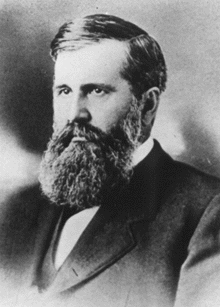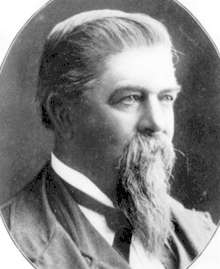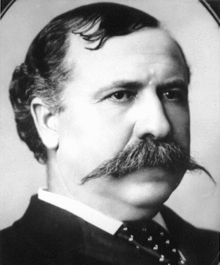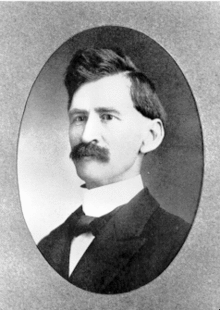Governor of Colorado
The governor of Colorado is the head of government of the U.S. state of Colorado. The governor is the head of the executive branch of Colorado's state government and is charged with enforcing state laws. The governor has the power to either approve or veto bills passed by the Colorado General Assembly, to convene the legislature, and to grant pardons, except in cases of treason or impeachment.[2] The governor is also the commander-in-chief of the state's military forces.
| Governor of Colorado | |
|---|---|
 Seal of the Executive Office | |
| Government of Colorado | |
| Style | The Honorable |
| Residence | Colorado Governor's Mansion |
| Term length | Four years, renewable once consecutively |
| Inaugural holder | John Long Routt |
| Formation | August 1, 1876 |
| Deputy | Dianne Primavera |
| Salary | $123,193 (2019)[1] |
| Website | www.colorado.gov/governor |
Seven people served as governor of Colorado Territory over eight terms, appointed by the president of the United States. Since statehood, there have been 38 governors, serving 43 distinct terms. One governor Alva Adams served three non-consecutive terms, while John Long Routt, James Hamilton Peabody, and Edwin C. Johnson each served during two non-consecutive periods. The longest-serving governors were Richard "Dick" Lamm (1975–1987) and Roy Romer (1987–1999), who each served 12 years over three terms. The shortest term occurred on March 16 and 17, 1905, when the state had three governors in the span of 24 hours: Alva Adams won the election, but soon after he took office, the legislature declared his opponent, James Hamilton Peabody, governor, but on the condition that he immediately resign, so that his lieutenant governor, Jesse McDonald, could be governor. Thus, Peabody served less than a day as governor.
The current governor is Democrat Jared Polis, who took office on January 8, 2019.
Governors
Governor of the Territory of Jefferson
The self-proclaimed Provisional Government of the Territory of Jefferson was organized on November 7, 1859.[3] Jefferson Territory included all of present-day Colorado, but extended about 3 miles (5 km) farther east, 138 miles (222 km) farther north, and about 50 miles (80 km) farther west.[4] The territory was never recognized by the federal government in the tumultuous days before the American Civil War. The Jefferson Territory had only one governor, Robert Williamson Steele, a pro-union Democrat elected by popular vote. He proclaimed the territory dissolved on June 6, 1861, several months after the official formation of the Colorado Territory, but only days after the arrival of its first governor.[5]
Governors of the Territory of Colorado
The Territory of Colorado was organized on February 28, 1861, from parts of the territories of New Mexico, Utah, and Nebraska, and the unorganized territory that was previously the western portion of Kansas Territory.[6]
| No. | Governor | Term in office[lower-alpha 1] | Appointed by | |
|---|---|---|---|---|
| 1 | .jpg.webp) |
William Gilpin (1813–1894) [7][8] |
March 25, 1861[lower-alpha 2] – March 26, 1862 (successor appointed)[lower-alpha 3] |
Abraham Lincoln |
| 2 |  |
John Evans (1814–1897) [12][13] |
March 26, 1862[lower-alpha 4] – October 17, 1865 (resigned)[lower-alpha 5] |
Abraham Lincoln |
| 3 |  |
Alexander Cummings (1810–1879) [17][18] |
October 17, 1865[lower-alpha 6] – May 8, 1867 (resigned)[lower-alpha 7] |
Andrew Johnson |
| 4 |  |
Alexander Cameron Hunt (1825–1894) [26][27] |
May 8, 1867[lower-alpha 8] – April 19, 1869 (successor appointed) |
Andrew Johnson |
| 5 |  |
Edward M. McCook (1833–1909) [30][31] |
April 19, 1869[lower-alpha 9] – April 17, 1873 (successor appointed)[lower-alpha 10] |
Ulysses S. Grant |
| 6 |  |
Samuel Hitt Elbert (1833–1899) [35][36] |
April 17, 1873[lower-alpha 11] – July 26, 1874[lower-alpha 12] (successor appointed) |
Ulysses S. Grant |
| 7 |  |
Edward M. McCook (1833–1909) [30][31] |
June 19, 1874[lower-alpha 13] – February 8, 1875 (successor appointed)[lower-alpha 14] |
Ulysses S. Grant |
| 8 |  |
John Long Routt (1826–1907) [45][46] |
February 8, 1875[lower-alpha 15] – November 3, 1876[lower-alpha 16] (elected state governor) |
Ulysses S. Grant |
Governors of the State of Colorado
The State of Colorado was admitted to the Union on August 1, 1876.
To serve as governor, one must be at least 30 years old, be a citizen of the United States, and have been a resident of the state for at least two years prior to election. The state constitution of 1876 originally called for election of the governor every two years, with their term beginning on the second Tuesday of the January following the election.[49] An amendment passed in 1956, taking effect in 1959, increased terms to four years.[50] Originally, there was no term limit applied to the governor; a 1990 amendment allowed governors to succeed themselves only once.[51] There is however no limit on the total number of terms one may serve as long as one who has served the two term limit is out of office for four years.
Should the office of governor become vacant, the lieutenant governor becomes governor.[52] If both the offices governor and lieutenant governor are vacant, the line of succession moves down through the senior members of the state senate and state house of representatives of the same party as the governor.[53] The lieutenant governor was elected separately from the governor until a 1968 amendment to the constitution[54] made it so that they are elected on the same ticket.[55]
See also
Notes
- The range given is from the date the governor was confirmed by the Senate, or appointed by the President during a Senate recess, to the date the governor's successor was confirmed, unless noted.
- Gilpin was nominated on March 22, 1861,[9] and confirmed by the Senate on March 25.[10] He arrived in the territory on May 27;[11] however, he was not formally sworn in until July 8,[7] after the territorial courts were set up.
- Gilpin was removed from office for improper financial drafts from the federal treasury.[8]
- Evans was nominated on March 18, 1862,[14] and confirmed by the Senate on March 26.[15] He was sworn in as governor in Washington, D.C., on April 11, and arrived in the territory on May 16.[16]
- Evans resigned at the request of President Johnson following the Sand Creek Massacre. The resignation was requested on July 18, 1865.[12]
- It is ambiguous exactly when Evans resigned and Cummings was appointed. Secretary of State William Seward requested Evans' resignation on July 18, 1865,[12] and Evans submitted it on September 4.[19] Modern sources say Cummings was appointed on October 17,[18] during a Senate recess, and sworn in to office on October 21;[17] however, contemporary news reported on his appointment as early as August 18,[20] and other major sources say he was appointed on August 8.[21] He was formally nominated on December 19,[22] and confirmed by the Senate on January 26, 1866.[23]
- Cummings resigned after being accused of misappropriating funds; despite being cleared of wrongdoing, his political career in the territory had been ruined.[24] Sources vary on when he resigned; modern sources almost all say April 1867,[17] but the best contemporary sources found say he tendered his resignation on May 8, the same day his successor was appointed.[25]
- Hunt was appointed on May 8, 1867,[25] during a Senate recess; nominated on July 20;[28] and confirmed by the Senate on November 29.[29]
- McCook was nominated on April 15, 1869,[32] confirmed by the Senate on April 19,[33] and took office on June 15.[30]
- Sources vary on why McCook left office. Grant's nomination of his successor specified that McCook declined reappointment;[34] the Colorado State Archives say locals petitioned for his removal;[31] and McMullin says Grant refused to reappoint him.[30]
- Elbert was nominated on March 19, 1873,[34] and confirmed by the Senate on March 20,[37] for a term to begin April 17.[34]
- Most sources do not specify when Elbert left office. According to news dated July 22, 1874, he was still claiming to be governor,[38] and that his successor likely arrived in the territory on July 26.[39]
- McCook was nominated on January 28, 1874,[40] and confirmed by the Senate on June 19.[41] He was sworn in out of state on June 26,[42] and took office in the territory probably on July 26.[39]
- Grant's appointment of McCook's successor specified that McCook resigned;[43] contemporary news reports say that he was asked to resign, but refused.[44]
- Routt was nominated and confirmed by the Senate on February 8, 1875,[43] and took office on March 29.[45][47][48]
- The state was admitted on August 1, 1876, but Routt was formally inaugurated as state governor on November 3.[58]
- Lieutenant governors represented the same party as their governor unless noted.
- Pitkin instead unsuccessfully ran for United States Senate.[60]
- Represented the Republican Party
- Thomas has been described as a fusion candidate, as he also had support from the People's Party.[81][83]
- Represented the Populist Party
- Orman was also nominated by the People's Party.[84]
- The Colorado State Archives labels Coates a Democrat;[87] however, a contemporary New York Times article describes him as a Populist elected on a fusion ticket, and that he had renounced all other parties and become a Socialist.[88]
- The 1904 election was rife with fraud and controversy. Alva Adams won election, but soon after he took office the Republican legislature declared James Peabody to be the actual winner, on the condition that Peabody immediately tender his resignation, postdated to the next day. Peabody's lieutenant governor, Jesse McDonald, then succeeded to the governorship.[92][93]
- The Colorado State Archives says Haggott served from 1902 to 1903; however, multiple sources say he served with Peabody[94] well into 1904,[95] so it is assumed the Archives are in error.
- Represented the Democratic Party
- Shafroth instead successfully ran for United States Senate.[102]
- Johnson resigned to take an elected seat in the United States Senate.[127]
- Carr instead unsuccessfully ran for United States Senate.[139]
- Knous resigned to take a seat on the United States District Court for the District of Colorado.[144]
- First term under a 1956 constitutional amendment, which lengthened terms to four years.[50]
- Love resigned to be Director of the Office of Energy Policy.[156]
- Polis' second term began on January 10, 2023, and will expire on January 12, 2027; he will be term-limited.
References
- General
- "Governors of Colorado". National Governors Association. Retrieved July 10, 2019.
- "Governors". Colorado State Archives. Retrieved December 14, 2018.
- "The Territorial Governors Collection". Colorado State Archives. Retrieved January 18, 2008.
- The University of Colorado Studies, volume IV. University of Colorado. 1907.
- Sobel, Robert (1978). Biographical directory of the governors of the United States, 1789-1978, Vol. I. Meckler Books. ISBN 9780930466015. Retrieved July 10, 2019.
- McMullin, Thomas A. (1984). Biographical directory of American territorial governors. Westport, CT : Meckler. ISBN 978-0-930466-11-4. Retrieved January 19, 2023.
- Constitutions
- "Constitution of the State of Colorado, as amended, annotated". Michie's Legal Resources. 1876. Archived from the original on May 5, 2012. Retrieved October 22, 2008.
- "Constitution of the State of Colorado" (PDF). Colorado State Archives. 1876. Retrieved October 22, 2008.
- Specific
- "Memorandum" (PDF). Legislative Council Staff. January 3, 2019. Retrieved August 6, 2019.
- CO Const. art IV
- University of Colorado Studies, p. 71
- University of Colorado Studies, p. 68
- University of Colorado Studies, pp. 75–76
- Thirty-sixth United States Congress (February 28, 1861). "An Act to provide a temporary Government for the Territory of Colorado" (PDF). State of Colorado, Department of Personnel and Administration, Colorado State Archives. Retrieved November 29, 2007.
- McMullin pp. 65–67
- "William Gilpin". Colorado State Archives. Retrieved February 10, 2023.
- U.S. Senate Exec. Journal. 37th Cong., special sess., 22 March 1861, 324. Accessed February 8, 2023.
- U.S. Senate Exec. Journal. 37th Cong., special st sess., 25 March 1861, 342. Accessed February 8, 2023.
- McGinnis, Ralph Y.; Calvin N. Smith (1994). Abraham Lincoln and the Western Territories. Rowman & Littlefield. p. 58. ISBN 0-8304-1247-6.
- McMullin pp. 67–68
- "John Evans". Colorado State Archives. Retrieved February 10, 2023.
- U.S. Senate Exec. Journal. 37th Cong., 2nd sess., 18 March 1862, 169. Accessed February 8, 2023.
- U.S. Senate Exec. Journal. 37th Cong., 2nd sess., 26 March 1862, 191. Accessed February 8, 2023.
- "John Evans". Colorado Encyclopedia. Retrieved February 10, 2023.
- McMullin pp. 69–70
- "Alexander Cummings". Colorado State Archives. Retrieved February 9, 2023.
- Baker, James H. (1927). History of Colorado. Linderman Co., Inc. p. 502. Retrieved February 9, 2023.
- "Cummings appointed". Alexandria Gazette. August 18, 1865. p. 1. Retrieved February 9, 2023.
- The Territorial Papers of the United States: Volume I: General. United States Government Publishing Office. 1934. p. 6.
- U.S. Senate Exec. Journal. 39th Cong., 1st sess., 19 December 1865, 306. Accessed February 9, 2023.
- U.S. Senate Exec. Journal. 39th Cong., 1st sess., 26 January 1866, 487. Accessed February 9, 2023.
- Hanchett, William (April 1957). ""His Turbulent Excellency," Alexander Cummings, Governor of Colorado Territory, 1865-1867" (PDF). The Colorado Magazine. XXXIV (2): 101–103. Retrieved January 12, 2023.
- "Cummings Tenders Resignation, Hunt Appointed". The Philadelphia Inquirer. May 9, 1867. p. 1. Retrieved February 9, 2023.
- McMullin pp. 70–72
- "Alexander Cameron Hunt". Colorado State Archives. Retrieved February 9, 2023.
- U.S. Senate Exec. Journal. 40th Cong., 1st sess., 20 July 1867, 851. Accessed February 9, 2023.
- U.S. Senate Exec. Journal. 40th Cong., 1st sess., 29 November 1867, 860. Accessed February 9, 2023.
- McMullin pp. 72–73
- "Edward Moody McCook". Colorado State Archives. Retrieved January 12, 2023.
- U.S. Senate Exec. Journal. 41st Cong., special sess., 15 April 1869, 182. Accessed February 9, 2023.
- U.S. Senate Exec. Journal. 41st Cong., special sess., 19 April 1869, 218–219. Accessed February 9, 2023.
- U.S. Senate Exec. Journal. 43rd Cong., special sess., 19 March 1873, 83. Accessed February 10, 2023.
- McMullin pp. 73–75
- "Samuel Hitt Elbert". Colorado State Archives. Retrieved February 10, 2023.
- U.S. Senate Exec. Journal. 43rd Cong., special sess., 20 March 1873, 90. Accessed February 10, 2023.
- "Elbert claims to be governor". The Summit County Beacon. July 22, 1874. p. 1. Retrieved February 10, 2023.
- "McCook arrives in Denver". The Daily Journal of Commerce. July 26, 1874. p. 3. Retrieved February 10, 2023.
- U.S. Senate Exec. Journal. 43rd Cong., 1st sess., 28 January 1874, 233. Accessed February 10, 2023.
- U.S. Senate Exec. Journal. 43rd Cong., 1st sess., 19 June 1874, 360–361. Accessed February 10, 2023.
- "McCook sworn in". The Democratic Leader. June 27, 1874. p. 1. Retrieved February 10, 2023.
- U.S. Senate Exec. Journal. 43rd Cong., 2nd sess., 8 February 1875, 507–508. Accessed February 10, 2023.
- "McCook declines to resign". The St. Louis Republican. February 3, 1875. p. 1. Retrieved February 10, 2023.
- McMullin pp. 75–76
- "John Long Routt". Colorado State Archives. Retrieved February 10, 2023.
- "Routt sworn in". Lawrence Daily Journal. April 1, 1875. p. 3. Retrieved February 10, 2023.
- "John Long Routt". Colorado State Archives. Retrieved February 10, 2023.
- CO Const. art IV, original section 1
- "Ballot History". Colorado Legislature. Retrieved December 4, 2008.
- "Ballot History". Colorado Legislature. Retrieved December 4, 2008.
- CO Const. art IV, sec 13
- CO Const. art IV, sec 13, paragraph 7
- "Ballot History". Colorado Legislature. Retrieved December 4, 2008.
- CO Const. art IV, sec 1
- Sobel p. 131
- "John Long Routt". National Governors Association. Retrieved February 10, 2023.
- "Inauguration of Governor". The Nebraska State Journal. November 4, 1876. p. 1. Retrieved February 10, 2023.
- Sobel pp. 131–132
- "Frederick Walker Pitkin". National Governors Association. Retrieved February 10, 2023.
- "Frederick W. Pitkin". Colorado State Archives. Retrieved February 10, 2023.
- Sobel pp. 132–133
- "James Benton Grant". National Governors Association. Retrieved February 10, 2023.
- "James Benton Grant". Colorado State Archives. Retrieved February 10, 2023.
- Sobel p. 133
- "Benjamin Harrison Eaton". National Governors Association. Retrieved February 10, 2023.
- "Benjamin Harrison Eaton". Colorado State Archives. Retrieved February 10, 2023.
- Sobel pp. 133–134
- "Alva Adams". National Governors Association. Retrieved February 10, 2023.
- "Alva Adams". Colorado State Archives. Retrieved February 10, 2023.
- Sobel p. 134
- "Job Adams Cooper". National Governors Association. Retrieved February 10, 2023.
- "Job A. Cooper". Colorado State Archives. Retrieved February 10, 2023.
- Sobel p. 135
- "Davis Hanson Waite". National Governors Association. Retrieved February 10, 2023.
- "Davis H. Waite". Colorado State Archives. Retrieved February 10, 2023.
- "New Executive". The Lamar Register. January 14, 1893. p. 7. Retrieved February 10, 2023.
- Sobel pp. 135–136
- "Albert Wills McIntire". National Governors Association. Retrieved February 10, 2023.
- "Albert W. McIntire". Colorado State Archives. Retrieved February 10, 2023.
- Sobel pp. 136–137
- "Charles Spalding Thomas". National Governors Association. Retrieved February 10, 2023.
- "Charles S. Thomas". Colorado State Archives. Retrieved February 10, 2023.
- Sobel p. 137
- "James Bradley Orman". National Governors Association. Retrieved February 10, 2023.
- "James B. Orman". Colorado State Archives. Retrieved February 10, 2023.
- "Lieutenant Governors of Colorado". Colorado State Archives. Retrieved October 25, 2009.
- "General Notes". The New York Times. July 13, 1902. Retrieved October 25, 2009.
- Sobel p. 138
- "James Hamilton Peabody". National Governors Association. Retrieved February 10, 2023.
- "James H. Peabody" (PDF). Colorado State Archives. Retrieved February 10, 2023.
- Powe, Lucas A. (1992). The Fourth Estate and the Constitution: Freedom of the Press in America. University of California Press. pp. 2–3. Retrieved December 14, 2018.
- "none". The Idaho Springs Siftings-News. March 18, 1905. p. 4. Retrieved February 10, 2023.
- Goodspeed, Weston Arthur (1904). The Province and the States: Missouri, Kansas, Colorado. p. 481. Retrieved October 25, 2009.
- "Shots Fired from Windows". The New York Times. June 6, 1904. Retrieved October 25, 2009.
- Sobel pp. 138–139
- "Jesse Fuller McDonald". National Governors Association. Retrieved February 10, 2023.
- "Jesse Fuller McDonald" (PDF). Colorado State Archives. Retrieved February 10, 2023.
- Sobel pp. 139–140
- "Henry Augustus Buchtel". National Governors Association. Retrieved February 10, 2023.
- "Dr. Henry A. Buchtel" (PDF). Colorado State Archives. Retrieved February 10, 2023.
- Sobel p. 140
- "John Franklin Shafroth". National Governors Association. Retrieved February 10, 2023.
- "John F. Shafroth" (PDF). Colorado State Archives. Retrieved February 10, 2023.
- Sobel p. 141
- "Elias Milton Ammons". National Governors Association. Retrieved February 13, 2023.
- "Elias M. Ammons" (PDF). Colorado State Archives. Retrieved February 13, 2023.
- Sobel pp. 141–142
- "George Alfred Carlson". National Governors Association. Retrieved February 13, 2023.
- "George Alfred Carlson" (PDF). Colorado State Archives. Retrieved February 13, 2023.
- Sobel p. 142
- "Julius Caldeen Gunter". National Governors Association. Retrieved February 13, 2023.
- "Julius C. Gunter" (PDF). Colorado State Archives. Retrieved February 13, 2023.
- Sobel p. 143
- "Oliver Henry Nelson Shoup". National Governors Association. Retrieved February 13, 2023.
- "Oliver H. Shoup" (PDF). Colorado State Archives. Retrieved February 13, 2023.
- Sobel pp. 143–144
- "William Ellery Sweet". National Governors Association. Retrieved February 13, 2023.
- "William E. Sweet" (PDF). Colorado State Archives. Retrieved February 13, 2023.
- Sobel p. 144
- "Clarence Morley". National Governors Association. Retrieved February 13, 2023.
- "Clarence Morley" (PDF). Colorado State Archives. Retrieved February 13, 2023.
- Sobel p. 145
- "William Herbert Adams". National Governors Association. Retrieved February 13, 2023.
- "William H. Adams" (PDF). Colorado State Archives. Retrieved February 13, 2023.
- Sobel pp. 145–146
- "Edwin Carl Johnson". National Governors Association. Retrieved February 13, 2023.
- "Edwin Johnson" (PDF). Colorado State Archives. Retrieved February 13, 2023.
- Sobel p. 146
- "Raymond Herbert Talbot". National Governors Association. Retrieved February 13, 2023.
- "Raymond H. Talbot" (PDF). Colorado State Archives. Retrieved February 13, 2023.
- "Colorado Has a New Governor". The Daily Sentinel. January 3, 1937. p. 14. Retrieved February 14, 2023.
- Sobel p. 147
- "Teller Ammons". National Governors Association. Retrieved February 13, 2023.
- "Teller Ammons" (PDF). Colorado State Archives. Retrieved February 13, 2023.
- Sobel pp. 147–148
- "Ralph Lawrence Carr". National Governors Association. Retrieved February 13, 2023.
- "Ralph L. Carr" (PDF). Colorado State Archives. Retrieved February 13, 2023.
- "Statistics of the Congressional Election of November 3, 1942" (PDF). Clerk of the United States House of Representatives. Retrieved July 2, 2014.
- Sobel pp. 148–149
- "John Charles Vivian". National Governors Association. Retrieved February 13, 2023.
- "John Charles Vivian" (PDF). Colorado State Archives. Retrieved February 13, 2023.
- Sobel p. 149
- "William Lee Knous". National Governors Association. Retrieved February 14, 2023.
- "William Lee Knous" (PDF). Colorado State Archives. Retrieved February 14, 2023.
- Sobel pp. 149–150
- "Walter Walfred Johnson". National Governors Association. Retrieved February 14, 2023.
- "Walter Walford Johnson" (PDF). Colorado State Archives. Retrieved February 14, 2023.
- Sobel p. 150
- "Daniel Isaac J. Thornton". National Governors Association. Retrieved February 14, 2023.
- "Daniel I. J. Thornton" (PDF). Colorado State Archives. Retrieved February 14, 2023.
- Sobel p. 151
- "Stephen Lucid Robert McNichols". National Governors Association. Retrieved February 14, 2023.
- "Stephen McNichols" (PDF). Colorado State Archives. Retrieved February 14, 2023.
- Sobel pp. 151–152
- "John Arthur Love". National Governors Association. Retrieved February 14, 2023.
- "John A. Love" (PDF). Colorado State Archives. Retrieved February 14, 2023.
- Sobel pp. 152–153
- "John D. Vanderhoof". National Governors Association. Retrieved February 14, 2023.
- "John Vanderhoof" (PDF). Colorado State Archives. Retrieved February 14, 2023.
- Sobel p. 153
- "Richard D. Lamm". National Governors Association. Retrieved February 14, 2023.
- "Roy Romer". National Governors Association. Retrieved February 14, 2023.
- "Bill Owens". National Governors Association. Retrieved February 14, 2023.
- "Bill Ritter". National Governors Association. Retrieved February 14, 2023.
- "John Hickenlooper". National Governors Association. Retrieved February 14, 2023.
- "Jared Polis". National Governors Association. Retrieved February 14, 2023.
.jpg.webp)





















.jpg.webp)
.gif)
.jpg.webp)
.jpg.webp)
.png.webp)

.jpg.webp)

.png.webp)
_(cropped).jpg.webp)
.png.webp)
.jpg.webp)
.jpg.webp)
.jpg.webp)

